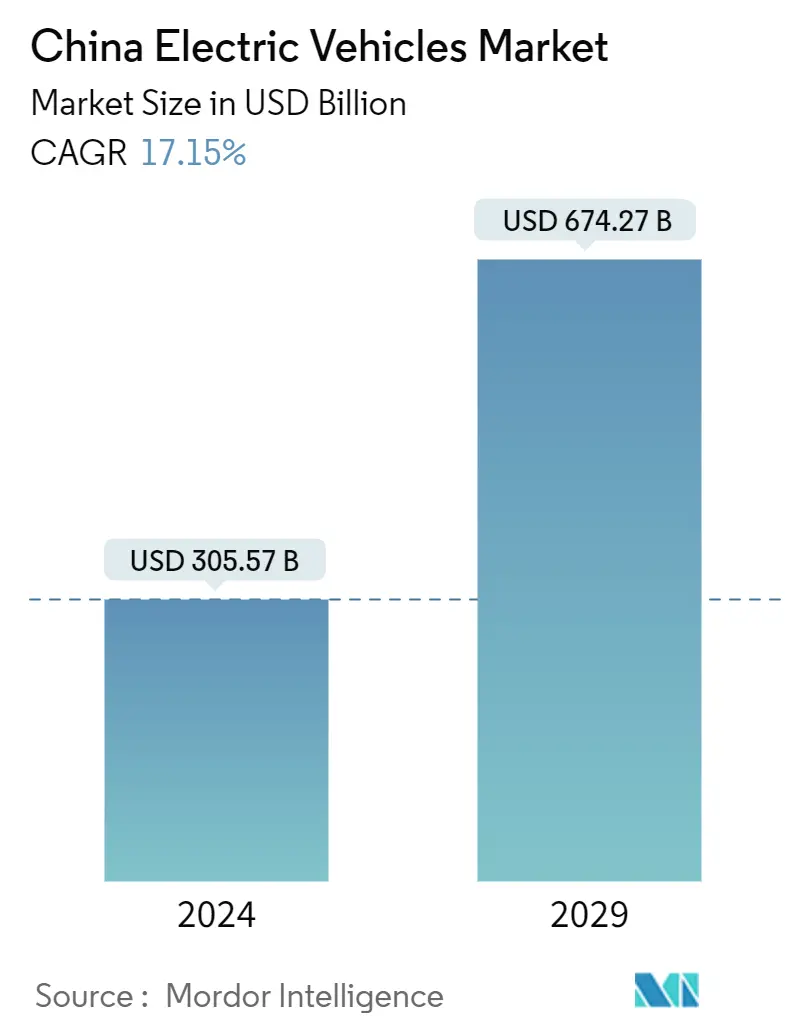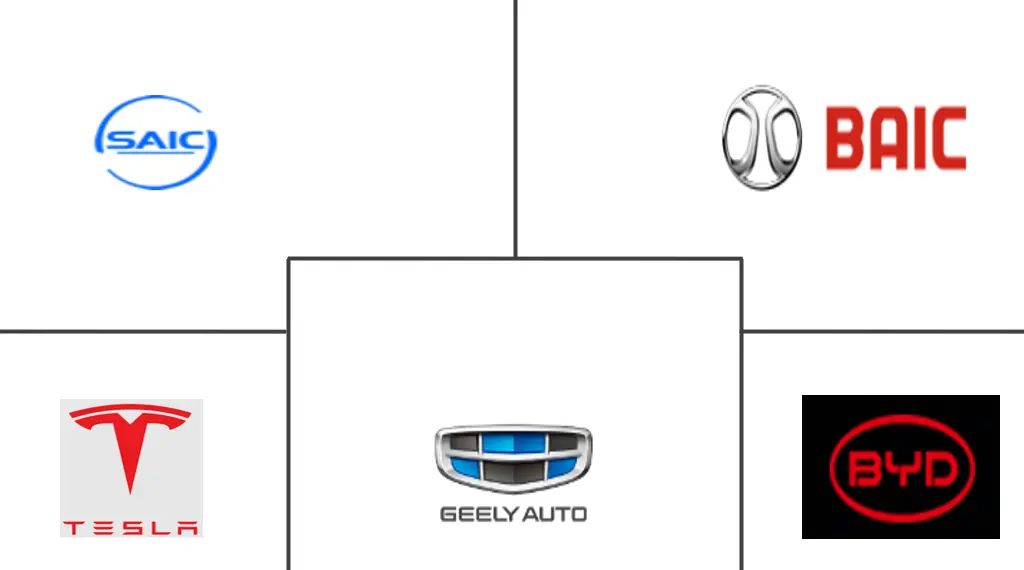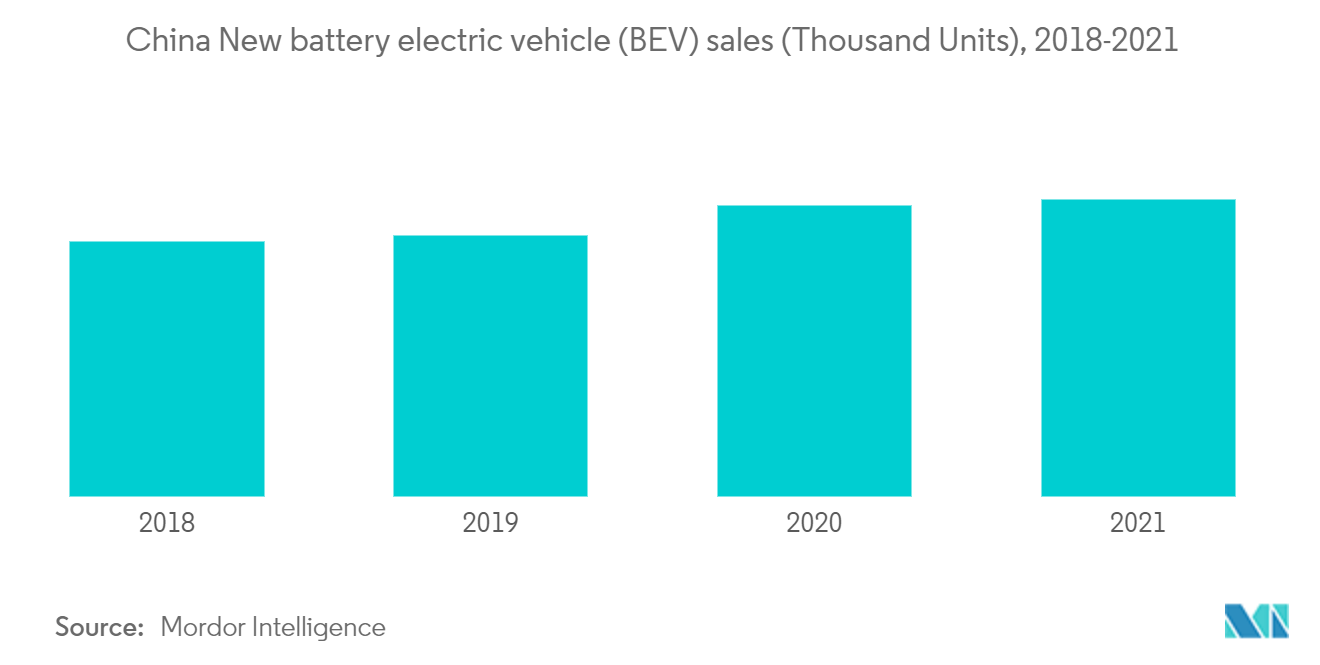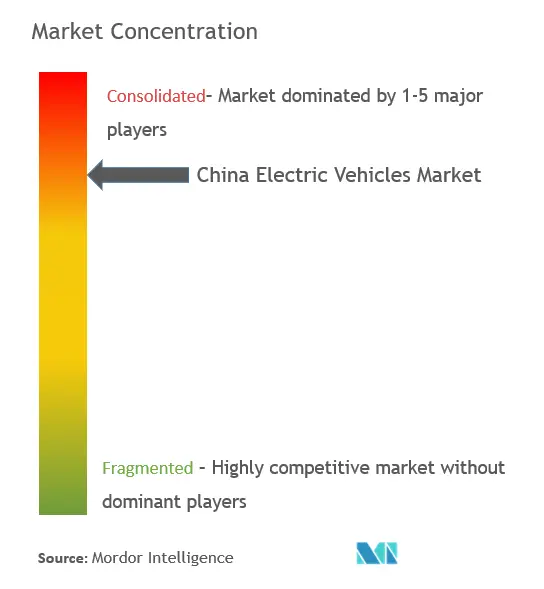China Electric Vehicles Market Size

| Study Period | 2019 - 2029 |
| Base Year For Estimation | 2023 |
| Market Size (2024) | USD 305.57 Billion |
| Market Size (2029) | USD 674.27 Billion |
| CAGR (2024 - 2029) | 17.15 % |
| Market Concentration | High |
Major Players
*Disclaimer: Major Players sorted in no particular order |
China Electric Vehicles Market Analysis
The China Electric Vehicles Market size is estimated at USD 305.57 billion in 2024, and is expected to reach USD 674.27 billion by 2029, growing at a CAGR of 17.15% during the forecast period (2024-2029).
The market was negatively impacted by COVID-19 in the first half of 2020. Market growth was disrupted owing to lockdowns and the reduced income of the population in China. Manufacturing and sales activities slowed and the supply chain was disrupted in the first half of 2020. The automotive industry in China witnessed significant growth in terms of the production of electric vehicles last year, and it is expected to continue during the forecast period.
Over the medium term, with the rise in exhaust emissions and rising environmental concerns, the country has been focusing on and working toward the development of sustainable transportation. This, in turn, has resulted in the electrification of its transport sector.
During the forecast period, the country may witness growth in the adoption of electric buses, as more than 30 Chinese cities have made plans to achieve 100% electrified public transit shortly, including Guangzhou, Zhuhai, Dongguan, Foshan, Zhongshan in the Pearl River Delta, along with Nanjing, Hangzhou, Shaanxi, and Shandong. EV sales account for about 60% of cities without a limit on vehicle increments. This indicates that there is still room for increased electric vehicle sales in China in the coming years.
China Electric Vehicles Market Trends
Tremendous Adoption Rate of Hybrid and Electric Vehicles due to Government Norms
With an increase in vehicle sales and rapid urbanization, China is determined to reduce exhaust emissions from vehicles. Meanwhile, the country plans to lessen its dependence on oil imports, boosting the demand for and sales of electric vehicles in the country. Furthermore, many key cities and provinces are imposing more strict restrictions. For instance, Beijing only issues 10,000 permits for the registration of combustion-engine vehicles per month to boost its inhabitants to switch to electric vehicles.
Growing government regulations improving electric vehicle adoption and robust expansion adopted by OEMs and suppliers in the region to accommodate rising demand from the automotive industry in China are expected to create a positive outlook for market growth during the forecast period. For instance, the Government of China is encouraging people to adopt electric vehicles. The country has already made plans to phase out diesel fuel, which runs the current generation of tractors and construction equipment. The country plans to ban all diesel and petrol vehicles by 2040. Also, in January 2021, BYD announced that it bagged a cumulative order to supply 1,002-unit pure-electric buses to Bogota, Colombia. These buses are scheduled to be delivered during 2021 and continue into the first half of 2022. They will be put into operation on 34 bus routes across five regions of the city.
The Chinese government invested in building charging stations across the country to promote electric vehicle sales. For instance, in January 2022, the Chinese government announced plans to build enough charging stations for 20 million electric vehicles by 2025.
For electric vehicles, the Chinese government has provided tax exemptions or lowered taxes. These initiatives by the government have attracted a lot of buyers to purchase EVs in this country. For instance, in September 2022, China's Ministry of Finance (MOF), the State Taxation Administration (STA), and the Ministry of Industry and Information Technology (MIIT) announced purchases of new energy vehicles (NEVs) that occur between January 1, 2023, and December 31, 2023, will continuously be exempted from vehicle purchase tax. Furthermore, China's Ministry of Transport offers subsidies and other benefits for the development of low-emission bus fleets, thereby further positively influencing the market. For instance, 61,000 more new energy buses were sold by Chinese bus makers in 2020, despite the pandemic. Such events are assisting China to formulate a resolute and optimistic prospect for the development of electric vehicles in the country, which is anticipated to propel the market.

The Passenger Cars Segment is Anticipated to Dominate the Market
Currently, the passenger cars segment is witnessing more demand than commercial vehicles, and it is expected to continue its dominance during the forecast period. The growth is due to the growing population, which provides for the growth of EVs. Stringent government emission norms are expected to drive sales of EVs. For instance, the Chinese government implemented China 6 norms for pollution control in the region, based on EUR 6 norms, in July 2020, which resulted in promoting the demand for hybrid vehicles in this region.
Several competitors have been driving the battery-electric vehicle market in China, along with generous government support. China extended the incentives related to the purchase of new energy vehicles (NEVs) until 2022.
Some non-automotive companies, like Alibaba, are entering the rapidly growing EV market in the country. For instance,
- In January 2021, Alibaba Group announced two electric models in the country under the IM (Intelligence in Motion) brand in partnership with SAIC Motor. Battery cells for these vehicles are provided by CATL. Of the two models launched, one is an electric sedan, and the other is an electric SUV. The sedan is anticipated to be launched first, with presale starting at Auto China 2021 in April, and the SUV may hit the market in 2022. The company informed that the vehicles may offer a 93-kWh battery, while a 115-kWh battery will be available as an option. Henceforth, the sedan may provide a range of up to 874 km in the NEDC cycle.
- In December 2020, Hyundai Motor Group announced its plans to present an electric-only platform in 2021, utilizing its battery technology to cut production costs and time.
- In September 2020, Tesla Inc. announced that it worked on reducing the cost of its EV batteries and increasing production. The cheapest Tesla was priced at USD 36,500 in 2021.
Due to the high number of local electric components and vehicles and the government's key national strategies and plans, it is expected that the country's market will achieve extraordinary growth in the coming years.

China Electric Vehicles Industry Overview
The Chinese electric vehicles market is dominated by a few players such as BAIC Motors, SAIC Motors, Honda Motor Company, Geely Motors, and BYD Co. BYD is the leading player in the Chinese electric vehicles market, owing to the increasing orders for its passenger cars and electric buses from the domestic and international markets. SAIC is expected to be the second-largest company, followed by Geely Motors and BAIC Motors. In order to develop advanced products and technologies, companies invest heavily in research and development.
- In June 2022, BMW AG opened its new factory in Shenyang, China. The company invested CNY 15 billion (USD 2.2 billion) to focus on electric vehicles.
- In February 2022, Danfoss announced that its Editron division successfully began mass production of its EM-PMI240-T180 motor, which is specifically designed for electric and hybrid drivetrains in buses at its Nanjing factory, located in eastern Jiangsu province.
- In June 2021, China Yuchai International Limited announced that it partnered with Guangxi Shenlong Automobile Manufacturing (Sun long) to develop four new energy powertrain systems, including an e-CVT power-split hybrid powertrain ("YC e-CVT"), integrated electric drive axle powertrain ("YC e-Axel") for new energy bus production in southern China.
- In February 2020, Honda Motor Company Ltd announced the beginning of its sales of all-new Honda Fit Hybrid vehicles. It is fortified with Honda's 2-motor hybrid system, which drives the vehicle with an electric motor, which results in a smooth drive and better fuel efficiency.
China Electric Vehicles Market Leaders
-
BYD Company Ltd
-
SAIC Motor Corporation Limited
-
BAIC Motor Corporation
-
Geely Auto Group
-
Tesla Inc.
*Disclaimer: Major Players sorted in no particular order

China Electric Vehicles Market News
- October 2022: Toyota Motor Corporation launched a small electric sedan, which will be powered by BYD Co. batteries and will be produced and sold in China.
- September 2022: Chery Automobile invested CNY 100 billion (USD 14.2 billion) in China over the next five years to strengthen facilities for smart electric vehicles (EVs) as part of its Yaoguang 2025 program.
- November 2021: Chinese electric vehicle manufacturer Xpeng announced the unveiling of a new smart EV (SUV) to compete with the likes of Tesla in the Chinese EV market.
- April 2021: Xpeng Motors launched the P5 sedan, which is a battery-electric vehicle. The P5 is equipped with lidar or light detection and ranging technology. It also has new autonomous driving features.
- March 2021: Geely launched the Zeekr premium EV. The company is expected to launch a new premium pickup truck by H2 of 2022 to compete with Rivian R1T.
- March 2021, Zhejiang Geely Holding Group, one of the biggest automakers in China and the owner of Volvo, announced the launch of an electric vehicle brand, Zeek. Zeek is intended to compete in the premium-EV segment in China, particularly against Tesla.
China Electric Vehicles Market Report - Table of Contents
1. INTRODUCTION
- 1.1 Study Assumptions
- 1.2 Scope of the Study
2. RESEARCH METHODOLOGY
3. EXECUTIVE SUMMARY
4. MARKET DYNAMICS
- 4.1 Market Drivers
- 4.2 Market Restraints
-
4.3 Porter's Five Forces Analysis
- 4.3.1 Threat of New Entrants
- 4.3.2 Bargaining Power of Buyers/Consumers
- 4.3.3 Bargaining Power of Suppliers
- 4.3.4 Threat of Substitute Products
- 4.3.5 Intensity of Competitive Rivalry
5. MARKET SEGMENTATION (Market Size by Value - USD Billion)
-
5.1 Drivetrain Type
- 5.1.1 Battery Electric Vehicles
- 5.1.2 Plug-in Hybrid Electric Vehicles
-
5.2 Vehicle Type
- 5.2.1 Passenger Cars
- 5.2.2 Commercial Vehicles
6. COMPETITIVE LANDSCAPE
- 6.1 Vendor Market Share
-
6.2 Company Profiles*
- 6.2.1 BAIC Motors Corporation
- 6.2.2 Honda Motor Company
- 6.2.3 Geely Auto Group
- 6.2.4 SAIC Motor Corporation Limited
- 6.2.5 BYD Company Ltd
- 6.2.6 Chery Motors
- 6.2.7 Jiangling Motors Corporation
- 6.2.8 JAC Motors
- 6.2.9 Changan Automobile
- 6.2.10 Great Wall Motors
- 6.2.11 Tesla Inc.
7. MARKET OPPORTUNITIES AND FUTURE TRENDS
** Subject To AvailablityChina Electric Vehicles Industry Segmentation
An electric vehicle (EV) operates on an electric motor instead of an internal combustion engine that generates power by burning a mix of fuel and gases. Rising pollution, global warming, and depleting natural resources are likely to see such a vehicle as a possible replacement for current-generation automobiles across the country.
The Chinese electric vehicle market is segmented by vehicle type and drivetrain type. Based on vehicle type, the market is segmented into passenger cars and commercial vehicles. Based on the drivetrain type, the market is segmented into battery-electric and plug-in hybrid electric vehicles. For each segment, market sizing and forecasting have been done based on value (USD billion).
| Drivetrain Type | Battery Electric Vehicles |
| Plug-in Hybrid Electric Vehicles | |
| Vehicle Type | Passenger Cars |
| Commercial Vehicles |
China Electric Vehicles Market Research FAQs
How big is the China Electric Vehicles Market?
The China Electric Vehicles Market size is expected to reach USD 305.57 billion in 2024 and grow at a CAGR of 17.15% to reach USD 674.27 billion by 2029.
What is the current China Electric Vehicles Market size?
In 2024, the China Electric Vehicles Market size is expected to reach USD 305.57 billion.
Who are the key players in China Electric Vehicles Market?
BYD Company Ltd, SAIC Motor Corporation Limited, BAIC Motor Corporation, Geely Auto Group and Tesla Inc. are the major companies operating in the China Electric Vehicles Market.
What years does this China Electric Vehicles Market cover, and what was the market size in 2023?
In 2023, the China Electric Vehicles Market size was estimated at USD 253.16 billion. The report covers the China Electric Vehicles Market historical market size for years: 2019, 2020, 2021, 2022 and 2023. The report also forecasts the China Electric Vehicles Market size for years: 2024, 2025, 2026, 2027, 2028 and 2029.
What are the key factors driving the China Electric Vehicle Market?
The key factors driving China Electric Vehicle Markets are: a) Stringent government emission norms b) Growing population, and c) Government incentives, including tax exemptions or lowered taxes for electric vehicles
China EV Industry Report
The electric vehicle market in China is witnessing significant growth, fueled by an increase in EV production and sales, the presence of key manufacturers, and escalating environmental concerns that are shifting focus towards sustainable transportation. This growth also extends to the light electric commercial vehicle market, which is seeing a surge due to the introduction of new electric commercial vehicles by OEMs. Despite potential hindrances such as high manufacturing costs and low battery range, the country is experiencing a rising demand for EVs for commercial applications. Various initiatives are being launched to boost electric car sales and curb vehicle emissions, with a particular emphasis on the development of battery electric vehicles and increasing efficiency across vehicle systems. However, the high cost of EVs compared to ICE vehicles and the limited range of EVs due to lower battery density may pose challenges to market growth.
The market share, industry outlook, industry trends, market forecast, market growth, market size, industry analysis, sales forecast, industry growth, market reports, global market, growth rate, market report, market trends, market value, industry reports, market data, market overview, market segmentation, market statistics, market leaders, industry research, market predictions, report pdf, report example, industry sales, research companies, market review, industry information, and target market are all critical aspects to consider in the current landscape of the Chinese electric vehicle market.
The Chinese electric vehicle market is poised for substantial growth, supported by comprehensive market analysis and robust industry statistics. The market outlook remains positive, with industry trends indicating a shift towards more sustainable transportation options. Market leaders are investing heavily in research and development to enhance the efficiency and affordability of electric vehicles. Industry reports and market data suggest that the market value of electric vehicles in China will continue to rise, driven by increasing consumer demand and favorable government policies.
In conclusion, the market segmentation and industry outlook for the Chinese electric vehicle market highlight the significant potential for growth and innovation in this sector. The market forecast and industry analysis provide a clear picture of the opportunities and challenges that lie ahead. With continued investment in technology and infrastructure, the Chinese electric vehicle market is set to become a major player in the global market.



